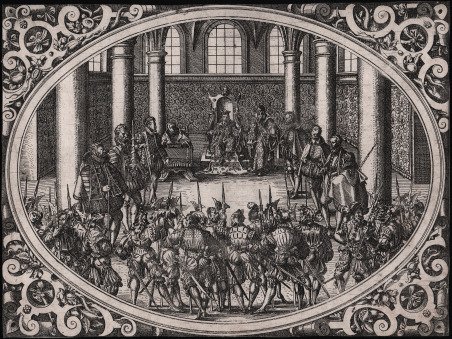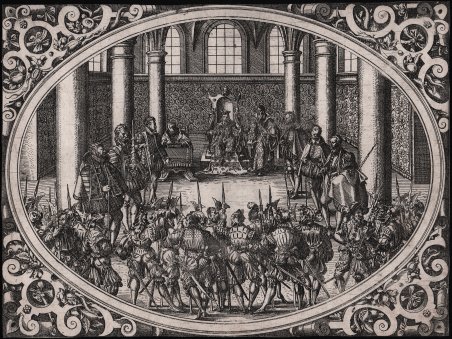Acquaforte su ferro, 1579 circa. Primo stato di due, avanti la numerazione. Pubblicata nel Catalogus gloriae mundi, di Barthélemy de Chasseneuz (ca. 1480-1541) – noto anche con la forma latinizzata del nome Bartholomaeus Cassaneus, edito Francoforte nel 1579 da Sigmund Feyerabend. La tavola raffigura un re seduto su un trono che tiene uno scettro sullo sfondo centrale, a sinistra uno scriba, ai lati della stanza i consiglieri del re, soldati in piedi in primo piano. Inserita in una cornice ovale, gli angoli riempiti con motivi ornamentali. Il Catalogus gloriae mundi, tipico prodotto dell’enciclopedismo rinascimentale, opera umanistica e giuridica, si incentrava sull’onore, problema per definizione interdisciplinare e di vastissimo successo nella pubblicistica cinquecentesca. Ma nel saggio di Chasseneuz il concetto di onore divenne addirittura la griglia di una vera e propria enciclopedia di tutto il creato. In dodici libri l’intera esperienza secolare e celeste si condensava compatta, ritrovando intorno all’onore il proprio archetipico motivo d’ordine: I. considerazioni generali sull’onore II. onori e ordini dell’uomo e della donna in generale III. onori e ordini degli spiriti celesti e infernali IV. onori e ordini degli ecclesiastici V. onori e ordini dei Principi VI. onori e ordini degli ufficiali del sacro palazzo VII. onori e ordini dei magistrati e di tutti gli ufficiali di giustizia VIII. onori e ordini dei nobili IX. onori e ordini dei militari X. onori e ordini delle scienze e dei letterati XI. onori e ordini dei plebei e degli artigiani XII. onori e ordini di pietre, vegetali, animali e di tutti i rimanenti esseri, celesti e terrestri. Di famiglia borghese, Bathélemy de Chasseneuz studiò diritto alle Università di Dole, Poitiers, Bologna, Torino e Pavia. Dopo l’occupazione del Ducato di Milano da parte di Carlo VIII vi svolse incarichi giudiziari, conseguì nel 1502 il dottorato in utroque ed accompagnò Charles d’Amboise nella sua spedizione contro Bologna. Esercitò poi l’avvocatura ad Autun, divenendo avvocato del Re e baglivo dell’abbazia di Saint Martin d’Autun. Consigliere nel parlamento di Digione dal 1525, nel parlamento di Parigi dal 1531, fu presidente in quello di Aix dal 1532. Morì nel 1541. Di lui rimangono a stampa una raccolta di pareri legali, i commentari sulle consuetudini del Ducato di Borgogna e, appunto, il Catalogo della gloria del mondo. La prima edizione dell’opera fu pubblicata nel 1529. Nel 1579 Sigmund Feyerabend, tipografo di Francoforte, decise di pubblicare una nuova edizione dell’opera, arricchita dalle illustrazioni realizzate ad hoc da Jost Amman allo scopo di rendere più facilmente comprensibili le teorie del giurista e valorizzare maggiormente l’opera. Magnifica prova, ricca di toni, impressa su carta vergata coeva, rifilata al rame, tracce di colla al verso, per il resto in ottimo stato di conservazione. Bibliografia The New Hollstein, Part VI.87.144.23.i, p. 87. Etching on iron, 1579, unlettered. First state, of two, before the numbering 6 added lower right in the plate. The plate depicts a king sitting on a throne holding a sceptre in centre background, on the left a scribe, on either side of the room the king's advisors, soldiers standing in the foreground. Set in an oval frame, the corners filled with strapwork ornaments. ' A fine impression, printed on contemporary laid paper, trimmed to the paltemark, very good condition. Printed in Catalogus Gloriae Mundi by Barthélemy de Chasseneuz, printed in 1579, Frankfurt - Sigmund Feyerabend. Barthélemy de Chasseneuz (1480–1541) was a lawyer, and he was neither a narrow-minded one nor a bad one – quite the opposite. He had attended French and Italian universities and had been the student of some of the most famous teachers of his time. The talented legal scholar had acquired experience at the court of the duke of Milan and even at the court of the Pope himself. And yet, he returned to his home country in 1506 where he took up high offices. As his contemporaries, Barthélemy de Chasseneuz was convinced that everything on earth had a precise order. He believed that any kind of dispute arose solely from the fact that humankind was unaware of the exact structure of this order. It was obvious that the King of France was of higher status than a juggler. But what about the King of France and the King of Aragon? Who of them was of higher status? Being a good lawyer, Chasseneuz sat down and studied the sources. He wrote more than 1,000 pages setting out which office held which rank based on all theological, philosophical and legal sources available to him – from the hierarchy of the Heavens to the social ranks of humankind and to animate and inanimate nature. In 1529, this book was published for the first time. Chasseneuz’ book was of huge importance to all those who had to deal with issues of ceremonial protocol. All princes and city councillors had enough money to afford an expensive book. That’s why, at some point during the 70s of the 16th century, Sigmund Feyerabend from Frankfurt decided to publish a new edition of Chasseneuz’ work. He did not simply reprint the first edition, instead, he hired the famous book illustrator Jost Amman to transform Barthélemy de Chasseneuz’ theoretical considerations into impressive – and easily understandable – copper engravings. Bibliografia The New Hollstein, Part VI.87.144.23.i, p. 87. Cfr.


Descubre cómo utilizar
Descubre cómo utilizar

